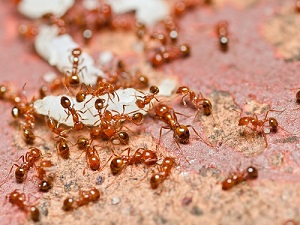If fire ants could be a threat in the work environment, emphasize these points during the safety meeting to keep your crews safe. Workers need to know how to recognize fire ant mounds, how to avoid them and what to do if they unexpectedly get bit and stung by these relentless creatures.

Often overlooked, injuries and deaths due to bees, spiders, and other insects are a concern that companies should manage as seriously as any other hazard in the workplace. Fatal on-the-job injuries do occur as a result of bites and stings from insects and spiders.
If employees are working outdoors or in any area where ants, insects, bees, wasps, ticks or spiders could be present, it would be a good idea to have an annual safety meeting on insects and spiders. Topics should include how to recognize and avoid potential areas where insects may be lurking, what clothing is best to wear in the working environment, reminders to keep work areas clean and basic first aid tips if any employee is bitten or stung.
OSHA Standard 1926.21(b)(4) says that in job site areas where harmful plants or animals are present, employees who may be exposed shall be instructed regarding the potential hazards, and how to avoid injury, and the first aid procedures to be used in the event of injury.

Fire ants may not be as deadly as bees or snakes, but if a worker gets bit by too many fire ants they may experience severe symptoms and loss of work time. At the very least they will be extremely uncomfortable and less productive the rest of the day and week. If fire ants could be a threat in the work environment, emphasize these points during the safety meeting.
- Inspect your work area before starting for signs of ants or fire ant mounds.
- Wear light-colored, smooth-finished clothing to cover as much of the body as possible.
- Keep work areas clean. Insects may be attracted to discarded food or open drink containers.
- Fire ants attack anything that disturbs their mound (nest). Avoid disturbing their mounds!
- Fire ants not only bite but they also sting. They are aggressive and inject venom that causes a burning sensation.
- After being bit by fire ants, red bumps form at the sting site and after a day or two they usually become white fluid-filled pustules.
- If attacked by fire ants, leave the area immediately and brush them off with a gloved hand or other cloth.
- Seek immediately medical attention if an insect bite or sting causes severe chest pain, nausea, severe sweating, loss of breath, serious swelling, or slurred speech.
- The venom from bees and ants can be extremely toxic to some people and even prove fatal.
- If workers are aware that they have a severe allergy to biting or stinging insects, they should consider using a medical warning bracelet or necklace or carry a wallet card.
.jpeg)

.jpg)